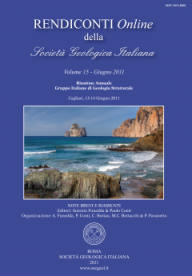
Time-space relationships of deformative structures in welded ignimbrites: the diapiric structures of the "Serra di Paringianu" Ignimbrite (SW Sardinia, Italy)
Filippo Mundula (*), Raffaello Cioni (*,**) & Maurizio Mulas (*)
(*) Dipartimento di Scienze della Terra, Università degli Studi di Cagliari, Via Trentino 51, 09127 Cagliari, Italy. E-mail: mundula@unica.it
(**) Istituto Nazionale di Geofisica e Vulcanologia, sezione di Pisa, Via Uguccione della Faggiola 32, 56126 Pisa, Italy.
Volume: 15/2011
Pages: 83-85
Abstract
The rheology of ignimbrites during welding and compaction has been matter of interest in recent years for the ability of welded ignimbrites to develop a wide variety of rheomorphic structures. The existence of numerical models able to reproduce the cooling-compaction history of welded ignimbrites allows to constrain the time scale for the development of specific rheomorphic structures and to test existing viscosity models.
The Serra di Paringianu rhyolitic ignimbrite represents the youngest major ignimbrite of the Cenozoic volcanism of SW Sardinia. It widely crops out on San Pietro and Sant'Antioco islands, while scattered outcrops are present in the Sulcis mainland. A detailed study of La Punta section, north of San Pietro Island, schematically characterized by a twin sequence of densely welded and partially welded ignimbrite units, reveals the presence of mushroom-shaped diapiric structures constituted by the partially welded intermediate unit intruding the upper densely welded cover.
We present a plume-like model in which the formation of diapiric structures is triggered by the density-driven buoyant rise of partially welded lithofacies into the densely welded cover in a time scale of few months. The model of emplacement of the diapiric structures takes into account the rheology of the host and intruding rocks and explains the textural and physical modification experienced by the partially welded lithofacies during rise and those induced in the host rock. After the vertical rise of the lighter material ceased, it started to expand laterally and degas. Diapiric structures are in fact closely associated in space to meter sized, lens-shaped voids (blisters), occurring in the upper densely welded lithofacies, interpreted as degassing structures where upward escape of gas was prevented by the impermeable nature of densely welded ignimbrite. Blisters could represent gas filled voids partially fed by the degassing head of the diapire.
Keywords
Get Full Text